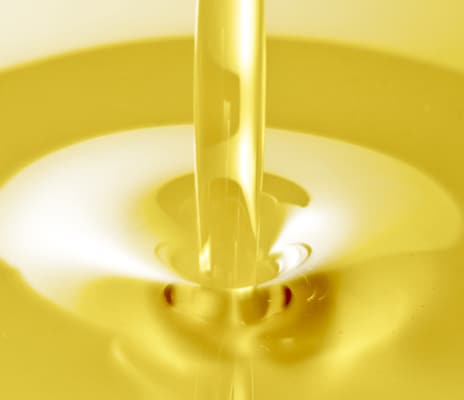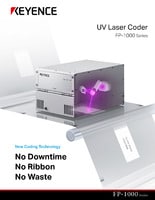Optimizing Food and Beverage Packaging with UV Laser Coding Technology
Over time, it has become evident how much UV laser coding has made it easier to package foods and beverages.

From medicinal packages to beverages, laser coding and marking should be your preferred method of marking your food and pharmaceutical products.
Understanding UV Laser Coding Technology
UV laser coding technology uses a focused beam of UV light to mark on packing materials. By doing so, you create a permanent, high-quality mark that is resistant to fading, scratching, or abrasion.

Oil

Powder

Alcohol

Heat sterilization

Conventional thermal printer

UV laser coder
* Results comparison after rubbing on the marked area of film exposed to powder before marking

How the UV Laser Coding Works
- A laser source generates a beam of UV light.
- The beam is focused onto a specific area of the material using a lens system.
- The focused laser beam interacts with the material. This interaction causes a physical or chemical change. Then, the contrast mark forms.
Key Components of a UV Coding System
- Laser Source: Generates the ultraviolet light beam.
- Optical System: Focuses the laser beam onto the material.
- Scanning System: Directs the laser beam across the material with precision.
- Control System: Where the overall operation is managed.
Comparison with Conventional Laser Coding and TTO Methods
UV laser coding technology offers many benefits over traditional methods in this case. Here are the differences between conventional laser coding and thermal transfer printing (TTO):
UV Laser Coding vs. Conventional Laser Coding
- Wavelength: The major feature of UV Lasers is that they use shorter wavelengths (i.e., around 355 nm), while conventional lasers are often around (1064 nm). The shorter wavelength allows increased absorption with less thermal effects.
- Marking Power: UV lasers can mark many materials while using less power than conventional lasers.
- Substrate Compatibility: UV Lasers are more compatible with a wider range of materials, including plastics, flexible films, and cardboard than conventional lasers.
- Speed: UV lasers can mark in milliseconds, typically two to three times faster than conventional laser coders, making them better suited for high-volume production.

CO2 laser: Generation of dust/odors

UV laser: No generation of dust/odors

Cross section of marked film
-
1CO2 laser
-
2Fiber laser
-
3UV laser
UV Laser Coding vs. Thermal Transfer Printing
- Mark Quality: UV laser coding operates by generating a chemical reaction with a substrate's pigment to create a permanent mark. In comparison, thermal transfer printing uses heat to transfer ink from a ribbon onto the surface of the material, which can be vulnerable to rubbing or scratching off.
- Surface Limitations: TTO is more limited in surface conditions than UV laser coding. For example, ink from TTO printers cannot adhere to wet or dusty surfaces, unlike UV lasers, which can produce marks even under these conditions.
- Environmental Impact: UV laser coding uses a dry process and does not produce any waste, while TTO uses ribbons that must be discarded after use.

Thermal printer

UV laser coder
UV Laser Coding vs. Thermal Transfer Printing
- Mark Quality: UV laser coding operates by generating a chemical reaction with a substrate's pigment to create a permanent mark. In comparison, thermal transfer printing uses heat to transfer ink from a ribbon onto the surface of the material, which can be vulnerable to rubbing or scratching off.
- Surface Limitations: TTO is more limited in surface conditions than UV laser coding. For example, ink from TTO printers cannot adhere to wet or dusty surfaces, unlike UV lasers, which can produce marks even under these conditions.
- Environmental Impact: UV laser coding uses a dry process and does not produce any waste, while TTO uses ribbons that must be discarded after use.
Advantages of UV Laser Coding for Food and Beverage Packaging
There are several benefits of UV laser coding for food and beverage packaging:
- Prevents Counterfeit Labels: According to the FDA, 1% of the global food industry is affected by fraudulent attacks, which is estimated to be around $40 billion a year. Laser-marked food packaging makes counterfeiting your product a harder task, as the marks are unique. Permanent codes are linked to verification databases, ensuring authenticity and traceability throughout the supply chain. At KEYENCE, we offer the UV laser coder FP-1000 Series.
- Reduce Label Waste: Traditional food packaging often involves glue, rubber, and other polymers—standard label printing also requires consumables like ink ribbons or specialty labels. Laser marking on food packaging eliminates the need for these additional materials, making this a sustainable and environmentally friendly option.
- Improved Recall Process: If your packaging has no original mark, the recall process is more challenging. When there's a need to recall a product due to contamination or other health hazards, having a high contrast, permanent laser mark can help with tracking and adherence to regulatory standards, ensuring all affected products are easily identified and removed from circulation.

Laser coding on film packaging offers additional advantages:
- High-resolution text, barcodes, and logos
- Clear marking on many surfaces
- Cost savings from reduced waste or rework due to improved accuracy
- Durability that stands up to harsh conditions like extreme temperatures or humid environments
- Ideal for high-volume production lines due to the high-absorption rate of UV laser wavelength
When it comes to your packaging needs, look no further than KEYENCE UV Laser Coding Systems. Laser markers will continue to provide food and beverage manufacturers with an efficient way to meet new labeling regulations.
The correct laser marking machines will also reduce the costs associated with waste and rework due to inaccurate labeling. With their flexibility and ability to mark on any surface without damaging it, UV laser markers make it easy for manufacturers to produce high-quality products that meet safety standards while still meeting customer demands quickly and accurately.
Applications of UV Laser Coding and Marking in the Food and Beverage Industry
Here are the applications of UV laser coding in the food and beverage industries:
- Unique Identification: With laser marking, manufacturers can assign unique identifiers like serial numbers, QR codes, and barcodes to their products. This ensures food safety and compliance with industry regulations.
- Rapid Recall: If you want to improve product safety, laser-marked identifiers are what you need for a swift and precise recall and to minimize consumer risk.
- Permanent and High-Quality Marks: This includes laser-marked logos, date codes, barcodes, and other branding elements. The marks are durable and resistant to fading throughout a product’s shelf life.
- Versatile Applications: Laser coding and marking can be applied to different ranges of packaging materials, from flexible films to cardboard, while offering flexibility in design and branding while meeting industry regulations.

Horizontal pillow-type packaging machines

Bag feeding machines (Rotary packaging machines)
* Double transfers also supported

Vertical pillow-type packaging machines

Stick packaging machines
Transform Your Food and Beverage Packaging with KEYENCE UV Laser Coding System
This UV laser coder is designed to replace your thermal transfer overprinter with no changes to your current packaging film or existing production line. UV laser coders will eliminate consumables and downtime while also increasing your production throughout.
Ready to upgrade your packaging line and experience the benefits of UV laser coding? The KEYENCE UV laser coder is the perfect solution for businesses looking to replace their thermal transfer overprinters without disrupting their production.


![UV Laser Marker Usage Guide [Food, Pharmaceutical, and Cosmetics Industry Edition]](/img/asset/AS_98694_L.jpg)

![Process-specific Marking Applications [Food/Pharmaceutical Industry]](/img/asset/AS_133442_L.jpg)

